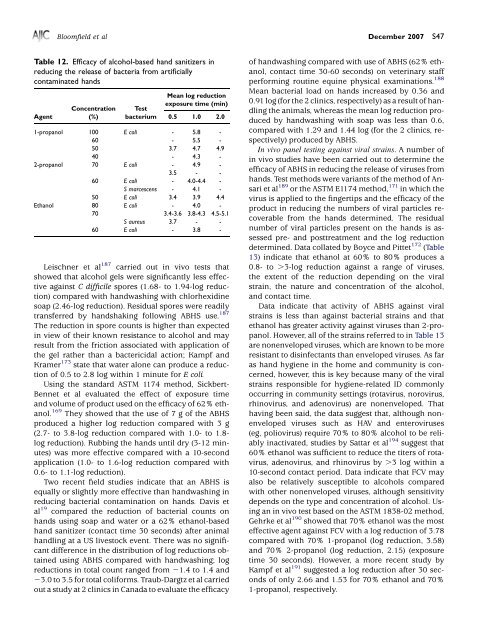The effectiveness of hand hygiene procedures in reducing the risks ...
The effectiveness of hand hygiene procedures in reducing the risks ...
The effectiveness of hand hygiene procedures in reducing the risks ...
Create successful ePaper yourself
Turn your PDF publications into a flip-book with our unique Google optimized e-Paper software.
Bloomfield et al December 2007 S47Table 12. Efficacy <strong>of</strong> alcohol-based <strong>hand</strong> sanitizers <strong>in</strong>reduc<strong>in</strong>g <strong>the</strong> release <strong>of</strong> bacteria from artificiallycontam<strong>in</strong>ated <strong>hand</strong>sAgentConcentration(%)TestbacteriumMean log reductionexposure time (m<strong>in</strong>)0.5 1.0 2.01-propanol 100 E coli - 5.8 -60 - 5.5 -50 3.7 4.7 4.940 - 4.3 -2-propanol 70 E coli - 4.9 -3.5 - -60 E coli - 4.0-4.4 -S marcescens - 4.1 -50 E coli 3.4 3.9 4.4Ethanol 80 E coli - 4.0 -70 3.4-3.6 3.8-4.3 4.5-5.1S aureus 3.7 - -60 E coli - 3.8 -Leischner et al 187 carried out <strong>in</strong> vivo tests thatshowed that alcohol gels were significantly less effectiveaga<strong>in</strong>st C difficile spores (1.68- to 1.94-log reduction)compared with <strong>hand</strong>wash<strong>in</strong>g with chlorhexid<strong>in</strong>esoap (2.46-log reduction). Residual spores were readilytransferred by <strong>hand</strong>shak<strong>in</strong>g follow<strong>in</strong>g ABHS use. 187<strong>The</strong> reduction <strong>in</strong> spore counts is higher than expected<strong>in</strong> view <strong>of</strong> <strong>the</strong>ir known resistance to alcohol and mayresult from <strong>the</strong> friction associated with application <strong>of</strong><strong>the</strong> gel ra<strong>the</strong>r than a bactericidal action; Kampf andKramer 173 state that water alone can produce a reduction<strong>of</strong> 0.5 to 2.8 log with<strong>in</strong> 1 m<strong>in</strong>ute for E coli.Us<strong>in</strong>g <strong>the</strong> standard ASTM 1174 method, Sickbert-Bennet et al evaluated <strong>the</strong> effect <strong>of</strong> exposure timeand volume <strong>of</strong> product used on <strong>the</strong> efficacy <strong>of</strong> 62% ethanol.169 <strong>The</strong>y showed that <strong>the</strong> use <strong>of</strong> 7 g <strong>of</strong> <strong>the</strong> ABHSproduced a higher log reduction compared with 3 g(2.7- to 3.8-log reduction compared with 1.0- to 1.8-log reduction). Rubb<strong>in</strong>g <strong>the</strong> <strong>hand</strong>s until dry (3-12 m<strong>in</strong>utes)was more effective compared with a 10-secondapplication (1.0- to 1.6-log reduction compared with0.6- to 1.1-log reduction).Two recent field studies <strong>in</strong>dicate that an ABHS isequally or slightly more effective than <strong>hand</strong>wash<strong>in</strong>g <strong>in</strong>reduc<strong>in</strong>g bacterial contam<strong>in</strong>ation on <strong>hand</strong>s. Davis etal 19 compared <strong>the</strong> reduction <strong>of</strong> bacterial counts on<strong>hand</strong>s us<strong>in</strong>g soap and water or a 62% ethanol-based<strong>hand</strong> sanitizer (contact time 30 seconds) after animal<strong>hand</strong>l<strong>in</strong>g at a US livestock event. <strong>The</strong>re was no significantdifference <strong>in</strong> <strong>the</strong> distribution <strong>of</strong> log reductions obta<strong>in</strong>edus<strong>in</strong>g ABHS compared with <strong>hand</strong>wash<strong>in</strong>g; logreductions <strong>in</strong> total count ranged from 21.4 to 1.4 and23.0 to 3.5 for total coliforms. Traub-Dargtz et al carriedout a study at 2 cl<strong>in</strong>ics <strong>in</strong> Canada to evaluate <strong>the</strong> efficacy<strong>of</strong> <strong>hand</strong>wash<strong>in</strong>g compared with use <strong>of</strong> ABHS (62% ethanol,contact time 30-60 seconds) on veter<strong>in</strong>ary staffperform<strong>in</strong>g rout<strong>in</strong>e equ<strong>in</strong>e physical exam<strong>in</strong>ations. 188Mean bacterial load on <strong>hand</strong>s <strong>in</strong>creased by 0.36 and0.91 log (for <strong>the</strong> 2 cl<strong>in</strong>ics, respectively) as a result <strong>of</strong> <strong>hand</strong>l<strong>in</strong>g<strong>the</strong> animals, whereas <strong>the</strong> mean log reduction producedby <strong>hand</strong>wash<strong>in</strong>g with soap was less than 0.6,compared with 1.29 and 1.44 log (for <strong>the</strong> 2 cl<strong>in</strong>ics, respectively)produced by ABHS.In vivo panel test<strong>in</strong>g aga<strong>in</strong>st viral stra<strong>in</strong>s. A number <strong>of</strong><strong>in</strong> vivo studies have been carried out to determ<strong>in</strong>e <strong>the</strong>efficacy <strong>of</strong> ABHS <strong>in</strong> reduc<strong>in</strong>g <strong>the</strong> release <strong>of</strong> viruses from<strong>hand</strong>s. Test methods were variants <strong>of</strong> <strong>the</strong> method <strong>of</strong> Ansariet al 189 or <strong>the</strong> ASTM E1174 method, 171 <strong>in</strong> which <strong>the</strong>virus is applied to <strong>the</strong> f<strong>in</strong>gertips and <strong>the</strong> efficacy <strong>of</strong> <strong>the</strong>product <strong>in</strong> reduc<strong>in</strong>g <strong>the</strong> numbers <strong>of</strong> viral particles recoverablefrom <strong>the</strong> <strong>hand</strong>s determ<strong>in</strong>ed. <strong>The</strong> residualnumber <strong>of</strong> viral particles present on <strong>the</strong> <strong>hand</strong>s is assessedpre- and posttreatment and <strong>the</strong> log reductiondeterm<strong>in</strong>ed. Data collated by Boyce and Pittet 172 (Table13) <strong>in</strong>dicate that ethanol at 60% to 80% produces a0.8- to .3-log reduction aga<strong>in</strong>st a range <strong>of</strong> viruses,<strong>the</strong> extent <strong>of</strong> <strong>the</strong> reduction depend<strong>in</strong>g on <strong>the</strong> viralstra<strong>in</strong>, <strong>the</strong> nature and concentration <strong>of</strong> <strong>the</strong> alcohol,and contact time.Data <strong>in</strong>dicate that activity <strong>of</strong> ABHS aga<strong>in</strong>st viralstra<strong>in</strong>s is less than aga<strong>in</strong>st bacterial stra<strong>in</strong>s and thatethanol has greater activity aga<strong>in</strong>st viruses than 2-propanol.However, all <strong>of</strong> <strong>the</strong> stra<strong>in</strong>s referred to <strong>in</strong> Table 13are nonenveloped viruses, which are known to be moreresistant to dis<strong>in</strong>fectants than enveloped viruses. As faras <strong>hand</strong> <strong>hygiene</strong> <strong>in</strong> <strong>the</strong> home and community is concerned,however, this is key because many <strong>of</strong> <strong>the</strong> viralstra<strong>in</strong>s responsible for <strong>hygiene</strong>-related ID commonlyoccurr<strong>in</strong>g <strong>in</strong> community sett<strong>in</strong>gs (rotavirus, norovirus,rh<strong>in</strong>ovirus, and adenovirus) are nonenveloped. Thathav<strong>in</strong>g been said, <strong>the</strong> data suggest that, although nonenvelopedviruses such as HAV and enteroviruses(eg, poliovirus) require 70% to 80% alcohol to be reliably<strong>in</strong>activated, studies by Sattar et al 194 suggest that60% ethanol was sufficient to reduce <strong>the</strong> titers <strong>of</strong> rotavirus,adenovirus, and rh<strong>in</strong>ovirus by .3 log with<strong>in</strong> a10-second contact period. Data <strong>in</strong>dicate that FCV mayalso be relatively susceptible to alcohols comparedwith o<strong>the</strong>r nonenveloped viruses, although sensitivitydepends on <strong>the</strong> type and concentration <strong>of</strong> alcohol. Us<strong>in</strong>gan <strong>in</strong> vivo test based on <strong>the</strong> ASTM 1838-02 method,Gehrke et al 190 showed that 70% ethanol was <strong>the</strong> mosteffective agent aga<strong>in</strong>st FCV with a log reduction <strong>of</strong> 3.78compared with 70% 1-propanol (log reduction, 3.58)and 70% 2-propanol (log reduction, 2.15) (exposuretime 30 seconds). However, a more recent study byKampf et al 191 suggested a log reduction after 30 seconds<strong>of</strong> only 2.66 and 1.53 for 70% ethanol and 70%1-propanol, respectively.


